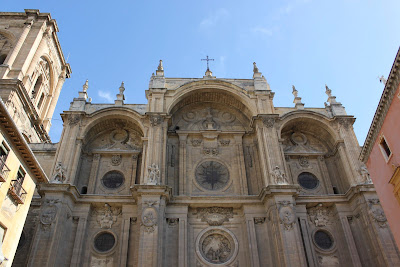Barcelona is promoted as a modern European metropolis. Its temperate climate, a killer location on Spain’s Mediterranean coast, but above all, its modern architectural style has made Barcelona an attractive city to visit. In this capital city of the Catalonia province, the Catalan Art Neoveau arose in the presence of an architectural scene of eclectic tastes. Above all else, it is the work of Antonio Gaudi (1852-1926) that stands out in this city.
Antoni Plàcid Guillem Gaudí i Cornet (Antonio Gaudi in its English translation) was a Spanish architect who is famous for his highly unusual and individual style that extended far beyond the scope of Modernisme. We spent the entire day exploring two of Gaudi’s brilliant pieces of work, both designated as UNESCO World Heritage Sites – Park Guell and The Temple of Sangrada Familia.
 |
| Sign at entrance of Park Guell, Barcelona |
The businessman Eusebi Guell conceived Park Guell as a garden city, which would bring together the ideal conditions of habitation in the middle of an insalubrious industrial city. He chose Gaudi, who had earlier worked on Guell’s palatial home on La Rambla Street (another Barcelona landmark). Gaudi worked on this park from 1900 to 1914, but the project was later abandoned as a commercial failure. The Barcelona City Council acquired it in 1918 and converted it into a public park in 1923. Park Guell is now one of the best public spaces in Barcelona.
 |
| Park Guell, Barcelona |
Park Guell was designed as a private urban development in the northern part of Barcelona known as Muntanya Pelada (Bald Mountain). In this rocky terrain full of slopes, Gaudi designed all the necessary services such as viaducts to distribute water, squares and streets, a large entrance stairway to a hall for a covered market. Over the roof of this hall is a large public square bordered by an ergonomically designed winding bench decorated with artwork done using broken tiles.
 |
| Public square on top of the columnar hall, Park Guell |
 |
| Gaudi's tile work, Park Guell |
The outstanding feature of Park Guell is its integration of architecture with nature. The Porter’s Pavilion and Keeper’s House Pavilion dominate the entrance, the former with its four-armed cross and both with attractive mushroom-shaped chimneys.
 |
| Porter's Pavilion (right) and Keeper's House Pavilion, Park Guell |
Gaudi’s most famous project and his labor of love is the Temple of Sagrada Familia. Being a devout Catholic, Gaudi devoted his later years to this project, which he designed to have 18 towers – one each for Jesus, Mary, the 12 apostles and 4 evangelists. Construction began in 1882, slowed down by 1912 due to personal tragedies in Gaudi’s life, the economic hard times in Barcelona and the death in 1918 of his patron, Eusebi Guell. In June 1926 Gaudi was himself hit by a tram and died three days later in a pauper’s hospital in Barcelona. He lies buried in La Sangrada Familia. The work on this project continues up to this day, some according to Gaudi’s original plans, much of which were destroyed in the Spanish Civil War. Work is likely to be completed around 2030, making this perhaps the only World Heritage Site that is still being built.
 |
| La Sagrada Familia, Barcelona |
La Sangrada Familia is a church of the basilican plan and with a Latin cross, has five naves in the central part and three in the transept. The limit on space has led to its optimum use and explains the cloister around the temple. The style of Sagrada Familia is Gothic, based on controlled geometric structures. It has a paraboloidal base structure, columns in the central nave and a tree-shaped columnar form that supports vaulting of a hyperbolic base and internal modulation of windows that filter and distribute light. Once complete, the church is estimated to accommodate 13,000 worshippers.
 |
| Interiors, La Sagrada Familia - The tree shaped columns |
 |
| Apostle Towers |
There are various symbolisms in the structures and the sculptures. Four towers on each of the three facades are dedicated to the twelve apostles, the first bishops of the church. For this reason, Episcopal symbols crown the pinnacles.
The anagram of the Holy Trinity crowns the cypress, the Tau – the first letter of the name of God in Greek, the cross in the form of the cross-piece of the Son (Jesus Christ) and the dove of the Holy Ghost.
 |
| Holy Trinity, Tau and the Doves |
Gaudi himself completed the eastern façade known as the Nativity Façade. It is ornamented in a baroque fashion with motifs of plants and animals, and of course a nativity scene. Opposite to it is the Passion Façade, on which work started in 1954 and was completed in 1987. The abstract figures, including those depicting the crucifixation, created a storm, as the style was very different from that of Gaudi. The work now focuses on the nave and the southern façade known as the Glory Façade, which will depict life and death.
 |
| Nativity Facade |
 |
| Passion Facade |
Entry to the under-construction church is 12 euros; a combined ticket for the church and the Park Guell museum can be purchased for 14 euros. An elevator ride up one of the towers followed by a short climb up the narrow stairs is another 2.5 euros. Beware – the elevator does not bring you down. It’s a long walk down narrow stairs. Those brave enough to go up and then walk down get fantastic views of Barcelona as well as close-up views of the church. It is a photographer’s delight.
 |
| Barcelona from Sagrada Familia Tower |






































